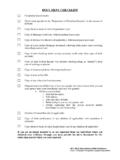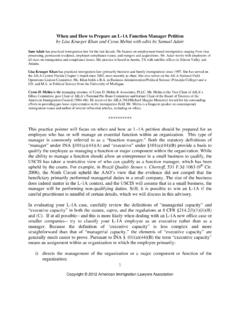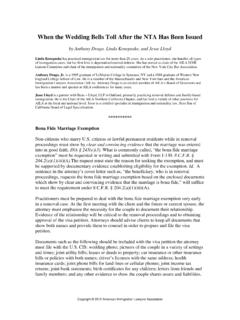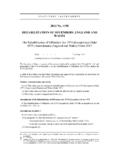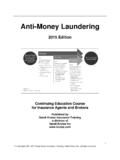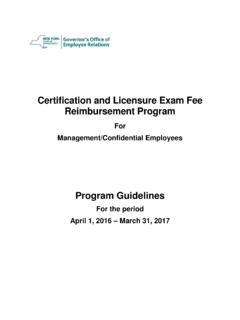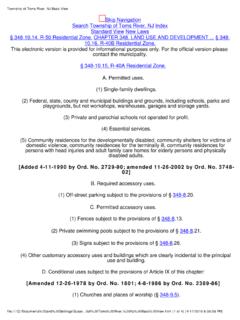Transcription of Cancellation of Removal - AILA webCLE
1 Copyright 2012 American Immigration Lawyers Association 1 Cancellation of Removal by Mark von Sternberg with edits by Scott Bratton & Shoba Wadhia Mark R. von Sternberg is a senior attorney with Catholic Charities Community Services/Archdiocese of New York where he concentrates on immigration and asylum litigation. He is a faculty member at Pace University School of Law where he teaches general immigration and comparative refugee law as well as at St. John s and New York Law Schools where he co-teaches an immigrant and refugee rights clinic. In 2002, he received the AILA Pro Bono Award. Scott Bratton is a partner at Margaret Wong & Associates Co.
2 , LPA in Cleveland. He heads the litigation and Removal department. His practice focus is litigation, Removal defense, asylum, complex adjustment and naturalization cases, and criminal law. Mr. Bratton is the Ohio AILA EOIR Liaison Chair. He is listed in Best Lawyers in America and Ohio Super Lawyers. Shoba Sivaprasad Wadhia is the founder/director of Penn State's Center for Immigrants' Rights where students produce practitioner toolkits, white papers, and primers of national impact on behalf of client organizations. Professor Wadhia researches the role of prosecutorial discretion in immigration law. Previously, she was deputy director for legal affairs at the National Immigration Forum and was an associate with Maggio + Kattar (both in Washington, DC) where she litigated asylum, deportation, and employment-based immigration benefits matters.
3 ** Cancellation of Removal is a formal remedy available to certain noncitizens who are able to meet the eligibility requirements under the immigration statute and qualify for relief as a matter of discretion. Recent judicial and administrative developments have significantly affected the right to apply for Cancellation of Removal Part B (non-LPR Cancellation ) and the omnibus waiver previously contained in section 212(c) of the Act (presently preserved for certain aliens whose convictions predated the passage of IIRIRA). These developments are discussed in this practice advisory. Section 240A(b)(1)(C) of the Act renders ineligible for Cancellation Part B any noncitizen who has been convicted of an offense under section 212(a)(2), under section 237(a)(2) or under 237(a)(3).
4 Essentially, these provisions relate to the statute s criminal grounds of deportability and inadmissibility. One portion of section 212(a)(2), for instance, creates a ground of inadmissibility for those who either are convicted of a crime involving moral turpitude (CIMT) or who admit the essential elements of such an offense. Section 237(a)(2) creates a ground of deportability for noncitizens who have been convicted of a CIMT punishable by at least one year in prison, provided that the crime was committed within five years of admission. Under the petty offense exception, a noncitizen would not be deemed inadmissible under section 212(a)(2) if the conviction (or admission of the crime) related to only one CIMT; the maximum sentence for that crime did not exceed one year; and, if the noncitizen had been sentenced, the sentence did not exceed six months confinement.
5 Practitioners representing noncitizens who appeared eligible for Cancellation Part B but for a conviction would customarily argue (if the applicant were being charged with inadmissibility) that the crime the individual was convicted of (or the crime which the applicant admitted having committed) was subject to the petty offense exception. The notion that the maximum sentence for the crime had to exceed one year for the offense to be taken out of the petty offense exception marks an extremely important divide in criminal jurisprudence Copyright 2012 American Immigration Lawyers Association 2generally.
6 In New York, for instance, crimes punishable by in excess of one year s confinement constitute felonies whereas those punishable by a year or less are generally misdemeanors. In Matter of Almanza-Arenas, 24 I&N Dec. 771 (BIA 2009), the Board of Immigration Appeals (Board) addressed the scope of Section 240A(b)(1)(C). The Board found that the determination of whether the crime is one involving moral turpitude for purposes of Section 240A(b)(1)(C) is governed by passage of the REAL ID Act of 2005, Division B of Pub. L. No. 109-13, 119 Stat. 231 (governing applications filed after May 11, 2005), which makes the noncitizen responsible for proving each element of his or her claim for lasting immigration relief.
7 Post-REAL ID, the Board ruled the applicant has the burden of establishing that he or she has not been convicted of a crime described in either the deportability or the inadmissibility provisions of the Act. In Almanza, the respondent was inadmissible and argued that he should have the benefit of the petty offense exception. The Board ruled, however, that he had been convicted of a CIMT punishable by at least one year s confinement; accordingly, even though he was not charged with being deportable, the applicant had been convicted of a crime described in the Act s deportability provisions, making him ineligible for Cancellation B under section 240A(b)(1)(C).
8 The Board in Almanza also turned the categorical analysis generally used in assessing criminal convictions on its head. Where the statute under which the alien has been convicted is severable, containing some provisions which reach CIMT s and some which do not, and it is not clear which provision the alien has been convicted under, the alien generally receives the benefit of the doubt under prevailing analysis and will not be deemed to have been convicted of a CIMT. Under Almanza, however, where the alien has been convicted under a divisible statute which arguably reaches both CIMT offenses as well as non-CIMT offenses, the alien bears the burden of establishing that he or she was convicted under the non-CIMT portion of the statute and must provide corroborating evidence to that effect.
9 In Matter of Cortez, 25 I&N Dec. 301 (BIA 2010), the Board took the analysis a step further. It ruled that a noncitizen is ineligible for Cancellation Part B where he or she had been convicted of an crime described in section 237(a)(2)(A) even where the crime had not been committed within five years of admission. Like the petty offense exception (which the Board had found irrelevant in Almanza), the Board in Cortez ruled that the language within five years of admission was largely extraneous to the type of crime which the statute described. The only elements which remained essential for the Board when interpreting application of section 240A(b)(1)(C) was (i) the nature of the crime being described [ , its turpitudinous character]; and (ii) the severity of the maximum sentence which could be imposed.
10 Almanza and Cortez substantially reverse the customary analysis used in cases where it is essential to assess the collateral consequences of weighty criminal convictions (or the admission of such crimes). Rather than turning to the historical analytic approach under which deportation statutes are to be construed in favor of the noncitizen since the Copyright 2012 American Immigration Lawyers Association 3practical result of deportation is banishment or exile, See Lok v. INS, 548 37 (2d. Cir. 1977), the Board has deliberately adopted a highly restrictive interpretation of the statute which promises to preclude many applicants from relief who heretofore would have been regarded as being eligible.


